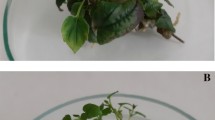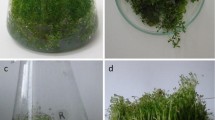Abstract
The ability of four races of the bean pathogenColletotrichum lindemuthianum to metabolize the phytoalexin phaseollin in shake cultures was compared. Apart from some differences in the rate of conversion, all races metabolized the phytoalexin in the same way. Phaseollin was first converted to 6a-hydroxyphaseollin, and this product was further metabolized to 6a, 7-dihydroxyphaseollin. No metabolites of the latter compound could be detected.
6a, 7-Dihydroxyphaseollin was as inhibitory as phaseollin to race δ11, but was only slightly inhibitory to races α1, α2 and γ1.
Samenvatting
Een vergelijkend onderzoek werd verricht naar het vermogen van vier fysiologische rassen van het bonepathogeenColletotrichum lindemuthianum om het fytoalexine phaseolline om te zetten.
In schudculturen waaraan 10 μg phaseolline/ml was toegevoegd, werd dit door alle fysio's op gelijke wijze omgezet, hoewel met verschillende snelheid (Fig. 1). Steeds werd phaseolline eerst omgezet tot 6a-hydroxyphaseolline, en dit produkt vervolgens tot een verbinding die geïdentificeerd kon worden als 6a, 7-dihydroxyphaseolline. Hierna konden geen verdere produkten worden aangetoond.
6a, 7-Dihydroxyphaseolline was even fungitoxisch als phaseolline voor fysio δ11, maar was slechts weinig fungitoxisch voor de fysio's α1, α2 en γ1 (Tabel 1).
De verschillen in omzettingssnelheid van phaseolline en in gevoeligheid voor phaseolline ee zijn omzettingsprodukten die tussen de fysio's gevonden zijn, zijn onvoldoende om de fysiospecifieke interacties tussen de boon en de verschillende fysio's vanC. lindemuthianum te verklaren.
Similar content being viewed by others
References
Bailey, J. A., 1974. The relationship between symptom expression and phytoalexin concentration in hypocotyls ofPhaseolus vulgaris infected withColletotrichum lindemuthianum Physiol. Pl. Path. 4: 477–488.
Burden, R. S., Bailey, J. A. & Vincent, G. G., 1974. Metabolism of phaseollin byColletotrichum lindemuthianum. Phytochemistry 13: 1789–1791.
Cruickshank, I. A. M., Biggs, D. R., Perrin, Dawn R. & Whittle, C. P., 1974. Phaseollin and phaseollidin relationships in infection-droplets on endocarp ofPhaseolus vulgaris. Physiol. Pl. Path.4: 261–276.
Heuvel, J. van den & Glazener, Judy A., 1975. Comparative abilities of fungi pathogenic and nonpathogenic to bean (Phaseolus vulgaris) to metabolize phaseollin. Neth. J. Pl. Path. 81: 125–137.
Heuvel, J. van den & VanEtten, H. D., 1973. Detoxification of phaseollin byFusarium solani f. sp. phaseoli. Physiol. Pl. Path. 3: 327–339.
Krebs, K. G., Heusser, D. & Wimmer, H., 1969. Spray reagents. In: E. Stahl (Ed.), Thin-layer chromatography. Springer-Verlag, Berlin, 2nd ed.: 854–909.
Martinez Salazar, E. & Andersen, A. L., 1957. Effects of temperature on spore germination and host infectivity by three strains ofColletotrichum lindemuthianum. Phytopathology 47: 23 (Abstr.).
Mathur, R. S., Barnett, H. L. & Lilly, V. G., 1950. Sporulation ofColletotrichum lindemuthianum in culture. Phytopathology 40: 104–114.
Author information
Authors and Affiliations
Rights and permissions
About this article
Cite this article
Van Den Heuvel, J., Vollaard, P.J. Metabolism of phaseollin by different races of Colletotrichum lindemuthianum. Netherlands Journal of Plant Pathology 82, 103–108 (1976). https://doi.org/10.1007/BF01976693
Accepted:
Issue Date:
DOI: https://doi.org/10.1007/BF01976693




